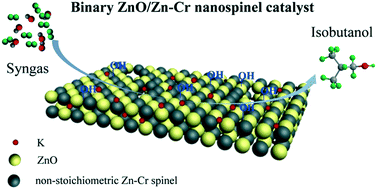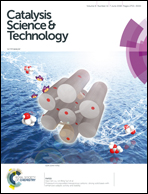Binary ZnO/Zn–Cr nanospinel catalysts prepared by a hydrothermal method for isobutanol synthesis from syngas†
Abstract
A series of binary ZnO/Zn–Cr nanospinel catalysts were prepared by a hydrothermal method and applied in direct synthesis of isobutanol from syngas, during which the effect of the hydrothermal time/temperature on the catalytic performance in the isobutanol synthesis has been investigated at 400 °C and 10 MPa. The catalysts were characterized by XRD, N2 adsorption–desorption, TPR, TPD, FT-IR spectroscopy, XPS, XRF, SEM and TEM. The XRD and TEM results show that the binary ZnO/Zn–Cr nanospinel structure forms well by the hydrothermal method. Compared with other ZnCr catalysts, the catalyst prepared under the hydrothermal conditions of 16 h and 160 °C has the largest BET area with the largest amount of active sites, leading to a high total alcohol production rate (TAPR). Meanwhile, the surface Zn/Cr molar ratio (1.27) and K content (1.64%) on the ZnCr-16-160 catalyst are higher. The enrichment phenomenon of Zn on the catalyst surface could improve the interaction between ZnO and a non-stoichiometric Zn–Cr spinel, forming a ZnO layer mixed with the Zn–Cr spinel. Since K is known as a C-chain increasing promoter, the high K content is helpful in improving the total alcohol and isobutanol selectivity. Thus, the appropriate hydrothermal time and temperature for the binary ZnO/Zn–Cr catalyst preparation are 16 h and 160 °C, respectively, and the best catalytic performance is obtained on the ZnCr-16-160 catalyst with a total alcohol selectivity of 60.2% and an isobutanol distribution of 27.0 wt%.



 Please wait while we load your content...
Please wait while we load your content...